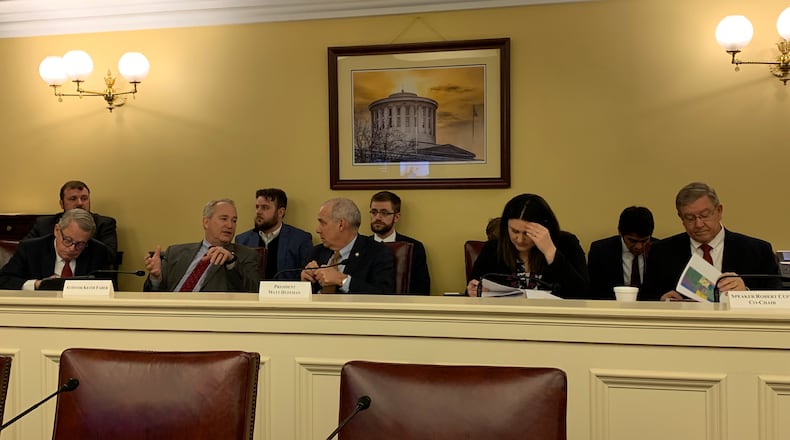The commission’s two Democratic members have publicly called for meetings, including in a letter sent Monday to the body’s five Republicans.
And plaintiffs in the months-long legal challenge to four sets of maps — all passed without Democratic support, and all thrown out by the Ohio Supreme Court as unconstitutionally favoring Republicans — are asking the court to hold commissioners in contempt for not meeting.
Yet the commission’s five Republicans — Gov. Mike DeWine; Senate President Matt Huffman, R-Lima; House Speaker Bob Cupp, R-Lima; Secretary of State Frank LaRose and Auditor Keith Faber — have maintained a wall of silence, with no meetings scheduled.
If Republicans run out the clock until May 28, they will get what they want: imposition of maps they already passed. That would be done by a panel of federal judges, although the state Supreme Court rejected those maps as gerrymandered on March 16.
Spokespeople for Cupp and Huffman did not answer requests for comment Tuesday. A spokesperson for Gov. Mike DeWine declined to comment.
The commission’s two Democratic members, state Sen. Vernon Sykes of Akron and House Minority Leader Allison Russo of Upper Arlington, have sent several letters to Republican members asking for more meetings, with the latest sent Monday night.
“It has now been 11 days since the Ohio Supreme Court ordered this commission to reconvene and draw constitutionally compliant state legislative district maps,” Sykes and Russo wrote. “We have contacted each of you repeatedly and asked you to join us in reconvening the commission to fulfill our constitutional obligations and comply with the court’s order.”
They also ask for the commission to rehire independent mapmakers Douglas Johnson and Michael McDonald and let them finish the district maps they produced in the last round of court-ordered map-drawing. Those independent maps were not quite complete on the afternoon of March 28, so Republican commissioners voted 4-3 to instead approve a slightly altered version of their previously rejected third plan. Faber joined Democrats in dissent, predicting correctly that state justices would find that unacceptable.
The League of Women Voters of Ohio, lead plaintiff in a months-long lawsuit challenging the Republican-drawn map proposals, asked the Ohio Supreme Court on Monday to renew a previously cancelled contempt hearing for members of the redistricting commission.
The filing says the court “unequivocally ordered the commission to ‘convene’ and draw a new plan by May 6, 2022.”
“It is April 25. There have been no meetings. No meetings have been scheduled. The independent map drawers have not been reengaged. And the repeated efforts by Commissioners Sykes and Russo to restart the proceedings have been ignored and rebuked,” it says.
Plaintiffs note that inaction means the already overturned third set of maps will probably be used in the eventual primary for state legislative seats.
“Given that time is of the essence, the court should direct the commissioners to meet and begin their work by no later than Friday, April 29, 2022,” the filing says, also asking the court to order rehiring of Johnson and McDonald to finish their maps.
In their repeated rejections of state legislative maps, state supreme court justices ordered a de facto reduction in Republican districts by insisting on a proportion of seats that met Ohio voters’ actual preferences in the last few elections. That breakdown is 54% Republican and 46% Democratic. Under the maps in place since 2012, Republicans hold a supermajority in both houses.
The rejected third set of maps would ostensibly create 54 Republican and 45 Democratic House seats, with 18 Republican and 15 Democratic Senate seats. But of those, 19 House and seven Senate seats would lean Democratic by less than 4%, while no Republican districts would be that close.
In a separate case, Gonidakis v. LaRose, Republicans asked a federal court to intervene. A three-judge panel initially declined, but on April 20 announced it would impose a set of maps if the state had not settled the issue by May 28.
Federal judges Amul Thapar and Benjamin Beaton said they would likely impose the third set of maps because county boards of elections had already done some preparatory work before it was rejected, meaning it should take less time to use in a likely Aug. 2 primary.
The panel’s third member, Algenon Marbley, chief district judge of the Southern District of Ohio, dissented; he called the third map set “irredeemably flawed,” proposing instead to order implementation of the plan drawn by Johnson and McDonald.
About the Author

